Let me be honest: I sincerely don’t know what to think of the Canon EOS M5. There, I said it. I’m sitting here in front of my computer trying to write some useful insights and I realise I don’t really have a clue.
Do I like it? No. Do I dislike it? No. Perhaps the best word would be: indifference. But indifference doesn’t help me write a review, or in this case, a hands-on review, or a first impressions review, or whatever can be considered appropriate for an article that basically says: I touched it!
That said, there is something I find interesting about the EOS M system. It is perhaps the only system that remains 100% committed to the idea of compactness. The question is whether Canon is doing this on purpose or if it is the result of a lack of motivation. What do I mean by this? Well, if you bear with me for a few more minutes, I’ll try to develop these thoughts into something that makes sense.
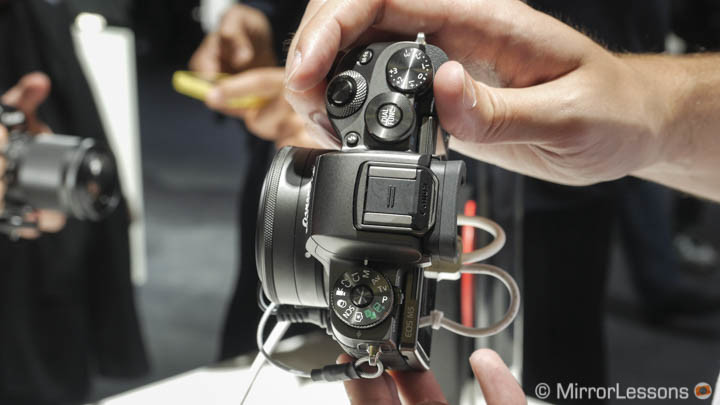
The EOS M5 is a small camera. It’s about the same size as a Fujifilm X-T10, probably a little smaller. The construction of the body didn’t impress me very much. It felt like a compact camera on steroids but the essential dials and buttons are there (twin dials for aperture/shutter speed, an exposure compensation dial, and a good number of buttons on the rear). It’s not an uncomfortable camera to hold by any means but it didn’t convince me. Maybe it is because I have big hands, which is the same feeling I had with the X-T10. The EVF is clear, bright and does the job it is supposed to do. The LCD monitor is nice, tilts up and down 180° and the touch screen is reactive.
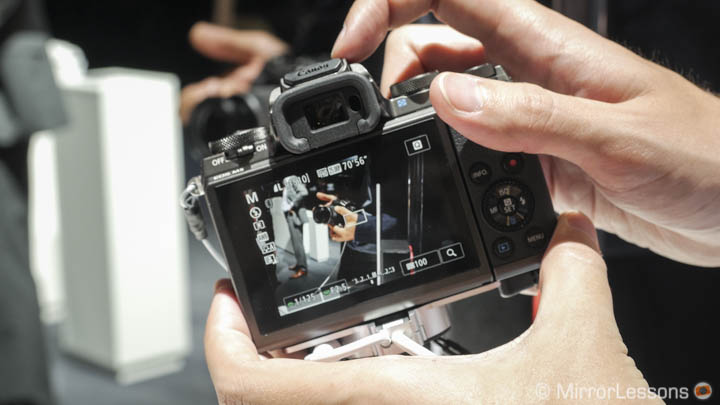
The 24MP sensor should provide enough quality for what you’d expect from an APS-C sensor these days (I couldn’t bring back some test shots). The video specifications are basic with Full HD up to 60fps and 5-axis hybrid stabilisation that is simply software stabilisation plus optical stabilisation with compatible lenses. In short, there isn’t anything in particular among these specifications that stands out from the crowd.
The AF is perhaps the most interesting aspect. Talking about its performance makes little sense for now as I could only get a vague idea of how fast the camera is. I have to say I wasn’t overly impressed but given its technology (Dual Pixel CMOS AF), I expect better performance in real-world conditions. Combined with 7fps, the M5 could be one of the best mirrorless cameras in Continuous AF with tracking (for video too) if the technology performs as well as some Canon DSLRs and Cine-cameras.
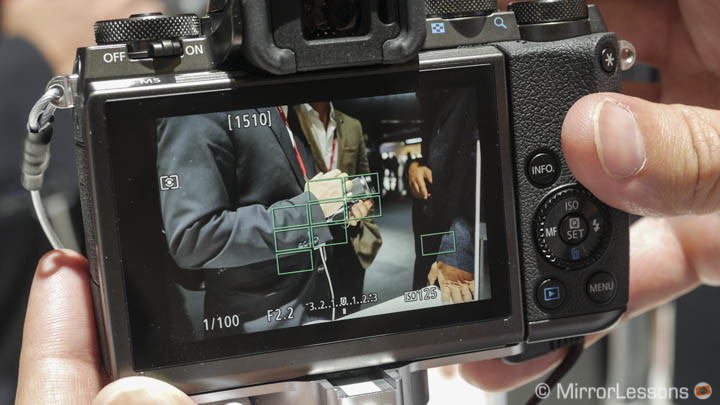
One interesting detail is Bluetooth: the camera maintains a constant low-power connection with your smartphone which should help you connect your mobile device via Wifi more quickly whenever you want to share a picture. However it would be nice if you could do everything via Bluetooth while using the camera. For example, it would be great if the camera could transfer images automatically.
The M5 desk at Canon’s booth was surprisingly crowded, even during the first days of the show. There is definitely a lot of interest in this new camera, probably more from current Canon DSLR users than other brands users.
After a few minutes of playing around with it, I gave the camera to the next person in line and left a little bit frustrated. Trying the camera in such conditions (body tied up to the desk, a big crowd around, people waiting and silently whispering “hurry-up!”) reminds me how uncomfortable a photo show can be, even just for a quick hands-on.
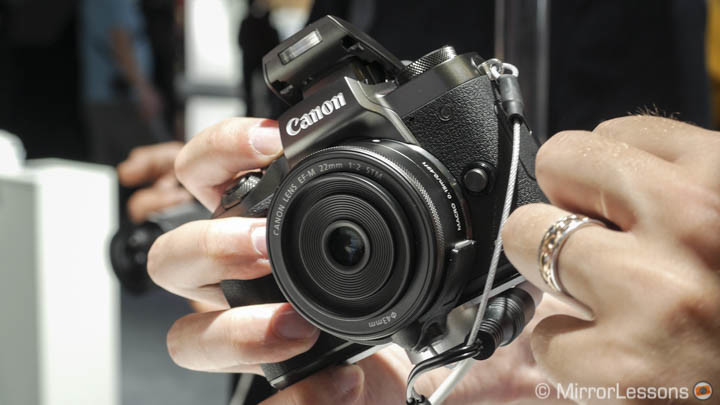
While I was walking away from the booth, I also thought about the lenses and that’s where I realised: yes, this is a compact system camera, perhaps smaller than any other today, but there is an easy explanation for this: most EOS M lenses aren’t fast. The only fast prime lens is the 22mm f/2 Pancake and then we have the 28mm f/3.5 Macro. All the other lenses are slow and affordable zooms with apertures varying between 3.5 and 6.3. So yes, the EOS M system is targeting beginners, amateurs or Canon shooters who want something smaller for their family holidays. If they were to design faster primes and zoom lenses, the size would increase considerably. We could complain about not having such an option but by limiting the lens line-up, they also manage to keep the system more compact.
The EOS M system hasn’t helped to advance mirrorless technology and Canon doesn’t seem interested in challenging the competition for the time being, but at the same time, for someone who doesn’t have large demands, the system gives what you need and remains much more compact than a Canon DSLR. The all-purpose 18-150mm 3.5-6.3, the 22mm f/2 pancake and perhaps the 11-22mm f/4-5.6 is all you need for most shooting conditions. (You can find out more about them in our Canon EOS M50 lenses guide on Mirrorless Comparison.)
It is only once your G.A.S. starts to grow and you start looking for more prime lenses or advanced gear that you’ll begin to see the limits of the EOS M system. And I think we can all agree that adapting Canon EF lenses to such a small body makes little sense.
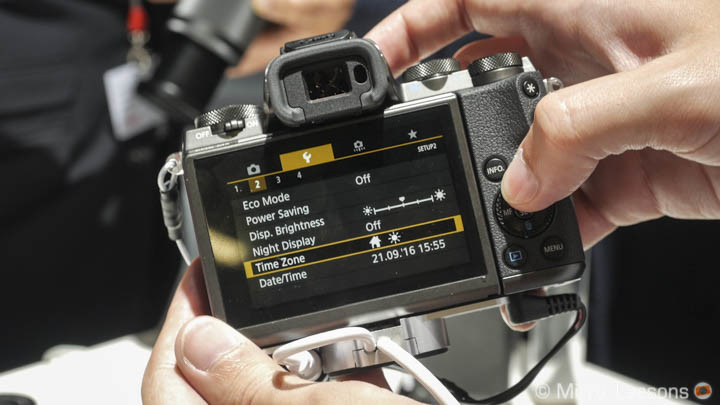
All things considered, the EOS M system is designed for Canon users or for users who would never bother to buy more than a couple of kit lenses. Is there something wrong in that? Maybe there isn’t.
We often accuse Canon of not being committed to the mirrorless (r)evolution or of not being innovative, even with some of its DSLR products (although that isn’t totally fair in my opinion). But as far as the mirrorless world is concerned, I don’t think it’s a bad thing. It gives more room to the other brands to expand and gives them the chance to build a solid reputation over time not only by acquiring new customers but by keeping them. And let’s not forget that many users switch to a mirrorless system because they’re are attracted to the smaller size, retro design or technological innovations. Not everyone chooses a mirrorless camera just because of the brand.
Let’s imagine for a second that Canon decided to release a more advanced mirrorless system.
Let’s imagine a full-frame camera with an excellent high resolution sensor, weather sealing, super fast AF, excellent continuous shooting capabilities and advanced video functionalities. Basically an advanced/pro body and a new series of lenses to make the camera as attractive as the best Sony, Fuji, Lumix and Olympus cameras. How many people would switch back to Canon (especially those who used Canon for years)? How much chance of success would this theoretical Canon camera have in comparison to the other brands? Canon is still popular and still sells lots of cameras, more than anybody else. This is probably the reason they are reluctant to go completely mirrorless but also why a serious mirrorless system of theirs could be very successful and pose a threat to the other companies.
It’s not always about being the first to release new technology – it’s more a question of being the first to mix it perfectly and introduce it at the right time. (Apple is a great example of this.)
For now, I think the Canon EOS M system is fine as it is. It’s not the most attractive system and it’s certainly not the most complete. It’s simply there to show that Canon has a mirrorless system but isn’t ready to compete with its own products. It’s harmless.
The question is: how much longer can Canon keep waiting and how much faster will the other brands grow?
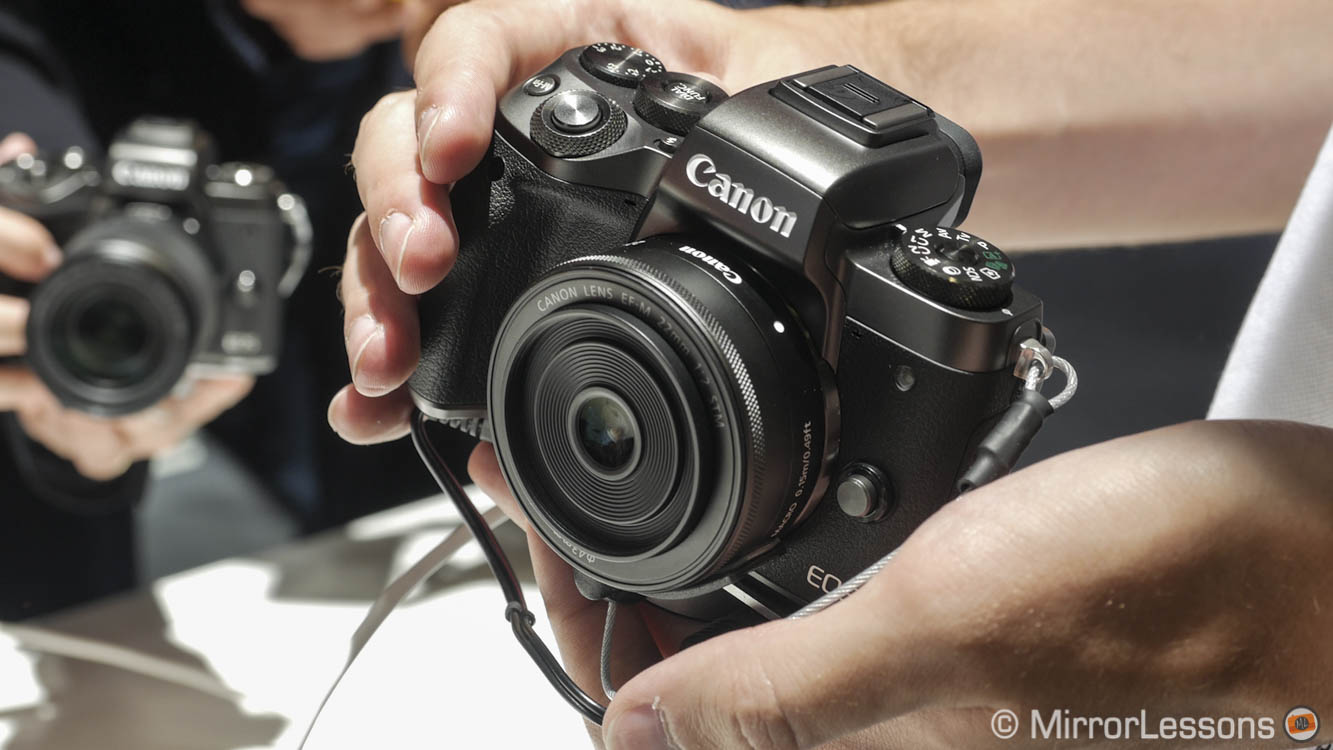
thank you for your kind reply.
Hi Eduardo, I think Canon (and Nikon) are just waiting for the appropriate moment to jump in the mirrorless market more seriously. And I think that moment is now close. Rumors about a full frame system from the two are increasing. If it is not this year it could be the next.
Sony is showing that mirrorless is not a matter of size but more a matter of technology (think about the A9) so Canon and Nikon need to develop a system based on the same idea. They have lenses, customers and more importantly long years of experience in making cameras. I just can see them failing with this unless their technology knowhow is now too inferior to Sony. But apparently Nikon has patented a stacked sensor just like the A9, so they might catch up soon. Sony has the best sensors, but Canon could improve its own. I think it’s going to be a very interesting next few years!
Hi Mathieu, I’d love to see an update of your thoughts given the recent release of the Sony a7iii and Sigma Sony Mount lenses. Am I right in thinking that Canon is know totally under pressure to answer your last statement above?
Thanks Johannes, we ask Canon if they can send us a copy of the camera, I hope they will send one soon!
Hi Mathieu, hi Heather,
I was interested to read your review about the EOS M5. I hope you are going to make a longer review on this camera. As you maybe know I do own quite a bit of Panasonic bodies and also µ43 lenses. I do have 8 years in mirrorless…
The M5 is really great camera – especially from the photographers point of view. It is on eyes hight with the best mirrorless cameras on the market – if you look @ IQ, Autofocus confidence and accuracy and overall handling.
Therefore: give it a longer review…. please…
PS We met @ Photokina….
OK I’m gambling. An M5 pre-ordered and I’m adding an EOS 400/5.6 just for this little body. IF it can truly AF-track then a wonderful small lightweight wildlife rig will result. If it can’t then the 22mm/2 will live on it slung around the shoulder for wides when I’m carrying larger EOS kit for BIF…..maybe the M5 can act as backup to the larger body. Time will tell.
I’m still surprised at this point no real world reviews/use in the field (wildlife) ???
Just consider it from the other side of the moon: take a Canon full frame DSLR with all advantages coming with, then let the prism and mirror disappear. Put an excellent EVF on t. You’ll get a small camera coping with the whole gamma of Canon lenses. THAT would be an atomic bomb !
Hard to guess without a proper test, especially with BIF. The AF system of the M5 should help, but it has yet to be seen how fast it can be with EF lenses.
Can anyone conjure a guess as to AF-tracking with EF lenses ?? Mat you held (tethered, like you were to steal it!) in hand–did you feel any magic mojo concerning popping on an EF lens and doing decent BIF?
I’m one of those EOS DSLR owners who has pre-ordered the M5 and for a couple of reasons-
1. support Canon in their mirrorless efforts=about time
2. lightweight compact kit when I don’t want to tote the heavies
3. the possibility to sub in a pinch for a Canon DSLR if it goes down (wishful at this point since I can find no hands on reports of AF,Af-tracking with EF lenses 🙁
Most brands develop many prototypes but not all of them hit the market. Fuji had a full frame/35mm camera in the works apparently, then they dropped the project and went medium format instead. I am sure Canon is no different 🙂
It is just a matter of time until Canon delivers a mirrorless that will on par if not exceed the best on the market. To think its R&D doesn’t have that mirrorless camera now would be foolish. As you said, Canon will deliver a great mirrorless product at the right time.
Well said….
I have the original EOS-M and an M3. I prefer the images from the original M, but prefer the controls on the M3. Neither can approach the sharpness of my preferred mirrorless, the Olympus E-P5 (probably because of the Panny/Leica lenses and 5 axis IS). No matter, I intend to sell the EOS M3 to buy the new Olympus 12-100mm F4.0 IS Pro lens.
my daughter uses an eos M (the first version) and usually a 55-200 full size canon lens and gets some incredible shots on it. her flickr is https://www.flickr.com/photos/140186376@N08 and I know I’m a proud dad but the camera gives such incredible shots and is half the equation when taking a shot. the other half is the person.
I think a lot of you are missing the point that the EF-M lens mount in 100% electrically compatible with the EF mount and thus the M5 can be used like a compact 80D with any Canon (or third party) EF or EF-S lens. All lens features are supported, including full AF and IS. Also, the same Dual Pixel Autofocus system as in the EOS-80D means that the M5 should focus DSLR lenses without the traditionally compromised performance of other mirrorless cameras.
In fact, since the M5 preserves 100% system compatibility with EOS lenses, flashes and other accessories, I expect this camera will be very popular with existing Canon users. Granted, it’s not going to take customers away from other mirrorless systems, but it will be a perfect entry point to mirrorless for many Canon DSLR users.
If you guys are really committed to the so-called “mirrorless revolution” you would welcome this move by the world’s leading ILC manufacturer to offer a mirrorless model with enthusiast specs. The M5 will likely bring quite a lot of new users over to your way of thinking. No need to be disappointed that Canon is not yet rushing headlong to disrupt its own EF lens and DSLR business–those products still serve an important audience of serious photographers. They will get around to a full frame mirrorless system camera in time, it’s inevitable.
In the meantime, we continue to have great choices no matter which style of gear we prefer.
I switched to Fuji earlier this year as well. Wonderful system and control that makes sense, just like in the film days.
Exactly.
Matthieu…you summed that situation up perfectly!
It’s true that many A7 users adapt DSLR lenses and even Sigma released their own adapter. If Canon would go with the full frame mirrorless route, I am sure they could release an adaptor of their own.
I went Fuji because it’s clear they’re going to support the X series well. Canon with their mirrorless are too indecisive for me to invest in.
I always liked the ergonomics of the M3. Canon has fantastic colour matching Fuji easily. Adapting FF DSLR lenses does defeat the point , but it was the foundation stone of Sony A7 cameras. Canon with the 5D Mark 4 can & will outlast the ‘in thing ‘ mirror less of the moment, but a serious FF rival to the Sony A7R 2 from Canon would be a very exiting proposition as again how many adapt Canon lenses to suit that??
‘It’s simply there to show that Canon has a mirrorless system but isn’t ready to compete with its own products. It’s harmless.’
Seems to sum it up quite nicely.
Actually, I rather think that Canon respects it’s consumers far more than Sony–and I am heavily invested in both Sony E and A Mounts as well as Canon FF systems and lenses. My Sony a7 suffered from sensors refraction, a7r from shutter shock, my a7rII has the same menu from Mars that each predecessor has. I have lost thousands simply trying out Sony’s mirrorless systems–as have many others. The highest rated FE lenses, with the exception of the FE ZA 35mm f2.8 and FE 55mm f1.8 totally blow the form factor which made such a systems initially so appealing. The Honda Accord or Toyota Camry–which both utilize proven, rather than “cutting edge” tech and buyer of this Canon M5 will likely get great image quality, true ease of use, proven failsafe tech, lenses which will preserve form factor and an investment that will not deteriorate in value by 55% in within 14 months of release as did the a7. Sony’s has taken its best shot and has presented some rather impressive tech. With this M5 release, Canon may not have shut offer the warm water heading into Sony’s sensor laden Jacuzzi but they have certainly loosened the drain…consumers considering mirrorless will now have a solid, if vanilla, choice from the world’s photographic market leader.
A bland case of me-tooism.
To me it feels like the M5 is too little too late. A couple of years ago this camera could have smashed competition, but now the only word I can think of is “meh”. And I’ve used Canon for over 14 years until I switched to a mirrorless
There is indeed nothing wrong with the camera, it seems like a fine piece of gear to me. The problem is there isn’t even one interesting lens. No fast zooms nor primes. If you compare this to Fuji’s line-up Canon still has a long way to go.
This is a really good piece, thank you.